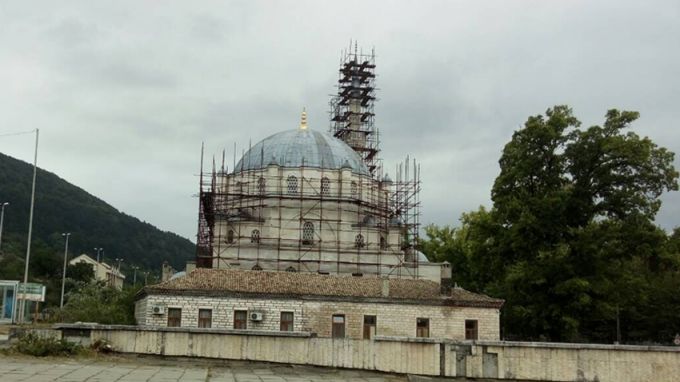 6
6
Shumen is a town known as one of the centers of the Bulgarian National Revival with its cultural and spiritual life, and where the spirit of past times can still be felt. If you go along the cobblestone street of "Tsar Osvoboditel" towards the Tombul Mosque, you will pass through the museum houses of some of the most prominent Bulgarian intellectuals and persons from the Revival, such as Panayot Volov, Lajos Kossuth, Pancho Vladigerov, Dobri Voynikov. Shumen is the birth place of Metropolitan Kliment of Turnovo (with secular name of Vassil Drumev), as well as the first mufti of Muslims in Bulgaria - Mehmet Muhyiddin. The mosque is located in the western part of the city, where the city center used to be in the past.
“To every thing there is a season, and a time to every purpose under the heaven... There is a time to break down, and a time to build up;" One starts thinking about these words from the Book of Ecclesiastes when approaching the Tombul Mosque - a Muslim temple that during the Bulgarian National Revival period was one of the most important religious, cultural and educational centers of Muslims in these lands. Besides being one of the symbols of Shumen, it is also a national monument of culture, part of the 100 National Tourist Sites of Bulgaria, but because of ongoing restoration work in recent years, the number of tourists visiting the mosque has decreased significantly.Tombul mosque was built in 1744 by benefactor Sheriff Halil Pasha and the mosque was named after him, but due to its round dome, which in Turkish is known as "tambul", the population started calling it "Tombul Mosque". The architectural style of the temple is influenced by the oriental “tulip” architectural style that originated in the early 18th century. The style is characterized by the presence of elements of the French Baroque. All parts of the architectural complex are included in a joint composition and are connected through patios. In the prayer hall one enters through an open entrance with high arcades in Moorish style. In his book “The Secrets of Tombul Mosque” Prof. Dobrin Dobrev of the Shumen University writes: "Tombul mosque is often described as one of the largest Muslim religious buildings on the Balkan Peninsula. The presence of a rich library that contains 800 manuscripts and 1500 old books is also traditionally pointed out."
In 2004, a study concerning the renovation of the mosque was carried out. In the period 2005-2008, some emergency activities on strengthening the temple's construction were carried out. Because of lack of funds, the restoration project was paused until 2016 when it was re-launched thanks to donations. Work includes a construction stage and a stage of artistic restoration.
"Tombul Mosque, according to me, in comparison to all mosques I have seen, excluding those under construction in the Middle East, has the richest decorations," says head of the artistic restoration stage Lyubomir Vodenicharov and adds:
"The most complicated thing in this mosque is that there are two periods of decoration exposed. One is the original one from the middle of the 18th century. And the other is a later one from the 19th century. This was necessary because the first decoration was linked to the aesthetics of Alevism. In the 19th century, due to some faults and the aesthetic considerations mentioned, the decoration was overwritten, but already with local elements of the Turkish Baroque used. We have reached an agreement that when a layer of the first period was discovered, it would be restored, and when a layer of the second period was discovered, it would be restored, too. We try to make sure that there is a distinct difference. Everything in the decoration is impressive because it is all hand-painted - no stencils were used."
English: Alexander Markov
Photos: Uzlem Tefikova and Radio ShumenOn this day 35 years ago, the authoritarian regime of communist dictator Todor Zhivkov collapsed. To mark the anniversary, the BGNES news agency carried out a survey of monuments to totalitarianism. The agency checked whether the monuments of the..
Residents and guests of the village of Kolena, Stara Zagora Municipality, gather for the Young Wine Festival. The event was celebrated for the first time in 2017, and a few years later the local teacher and winemaker Martin Slavov gave the..
The tallest Ferris wheel in Bulgaria will rise above Pleven , announced regional governor Nikolay Abrashev. It will be built in a multifunctional complex near the Kaylaka Park. "The project envisages the construction of a Ferris wheel with a..
The 33rd Bulgarian polar expedition is heading to Antarctica to continue its scientific research in cooperation with scientists from different countries...
The town of Elena, Veliko Tarnovo region, will welcome thousands of guests for the Feast of the Elena pork leg meat delicacy . Balkan masters will..
The tallest Ferris wheel in Bulgaria will rise above Pleven , announced regional governor Nikolay Abrashev. It will be built in a multifunctional complex..

+359 2 9336 661
